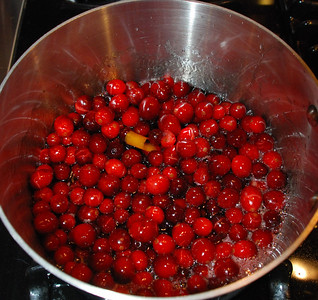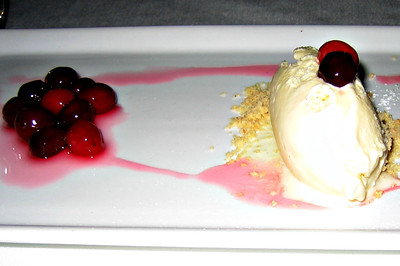
I feel sorry for the cranberry. Each holiday season it slides out of its tin can with a gelatinous plop. Just when it thinks, “I’m free to do something amazing culinarily,” someone grabs a spoon and turns it into a jellied, crimson mush. If it’s lucky, it might show up later in a wizened, albeit more true-to-life form in muffins, scones, or salads. When it’s unlucky, it appears in my breakfast juice glass. That seems to be all that we can come up with for this amazing fruit.
Long before it was known as a cranberry, this Vitamin C-rich berry was called a cowberry. As you might have guessed from the name, cows adore it. Thinking that the fruit’s pink blossom resembled the head and bill of a crane, Pilgrims later named it a craneberry. Because it bounces when ripe, it’s also referred to as a bounceberry.
The hardy offspring of low, scrubby plants, the cranberry can be found in some of Northern Europe’s and America’s poorest, most acidic soils. You’ll see it growing wild in bogs and on mountainsides and moors.
Along with thriving in lousy conditions the cranberry can survive a long time off the vine. Its durability comes from its deep red, waxy skin, which contains benzoic acid, a natural preservative that keeps it fresh for months after picking. Because of its sturdiness, sea-going sailors and whalers used to take along the tart berry to prevent scurvy. Fresh cranberries will keep for over two months in my refrigerator or a year in my freezer.

Native Americans taught early American settlers to eat fresh and dried cranberries. They used them in preserved meats and made them into sauces. Perhaps this is why I associate the fruit with Thanksgiving and as the dressing for my roast turkey.
Although we most often see cranberries either dried, as a juice, or in a can, they are phenomenal when featured fresh in chutneys and preserves. Fresh cranberries make fabulous pies, cobblers, crumbles, and tarts. They also do a great job flavoring meats and stuffings and perking up cocktails.
CRANBERRY FOOL
From The Gourmet Cookbook (Conde Nast Publications, 2004)
Serves 4
1 1/2 cups fresh cranberries, picked over and rinsed
2/3 cup sugar
1/3 cup water
2 tablespoons Grand Marnier or other orange-flavored liqueur
2/3 cup very cold heavy cream
Combine the berries, sugar and water in a 1-quart saucepan and bring to a boil, stirring occasionally. Reduce the heat and simmer, covered, for 5 minutes.
Transfer the cranberry mixture to a food processor or blender and puree. Force the puree through a fine-mesh sieve into a medium metal bowl. Discard the solids. Set the bowl in a larger bowl of ice and cold water. Let the puree stand, stirring occasionally, until just cool.
Transfer 1/2 cup cranberry puree to a small bowl. Beat the heavy cream in a medium bowl with an electric mixer until soft peaks hold. Stir one quarter of whipped cream into the puree remaining in the medium bowl then gently but thoroughly fold in the remaining whipped cream. Fold in the reserved puree just until marbled through the cream mixture.
Spoon the fool into 4 stemmed glasses. Refrigerate for 20 minutes or freeze for 10 minutes before serving.